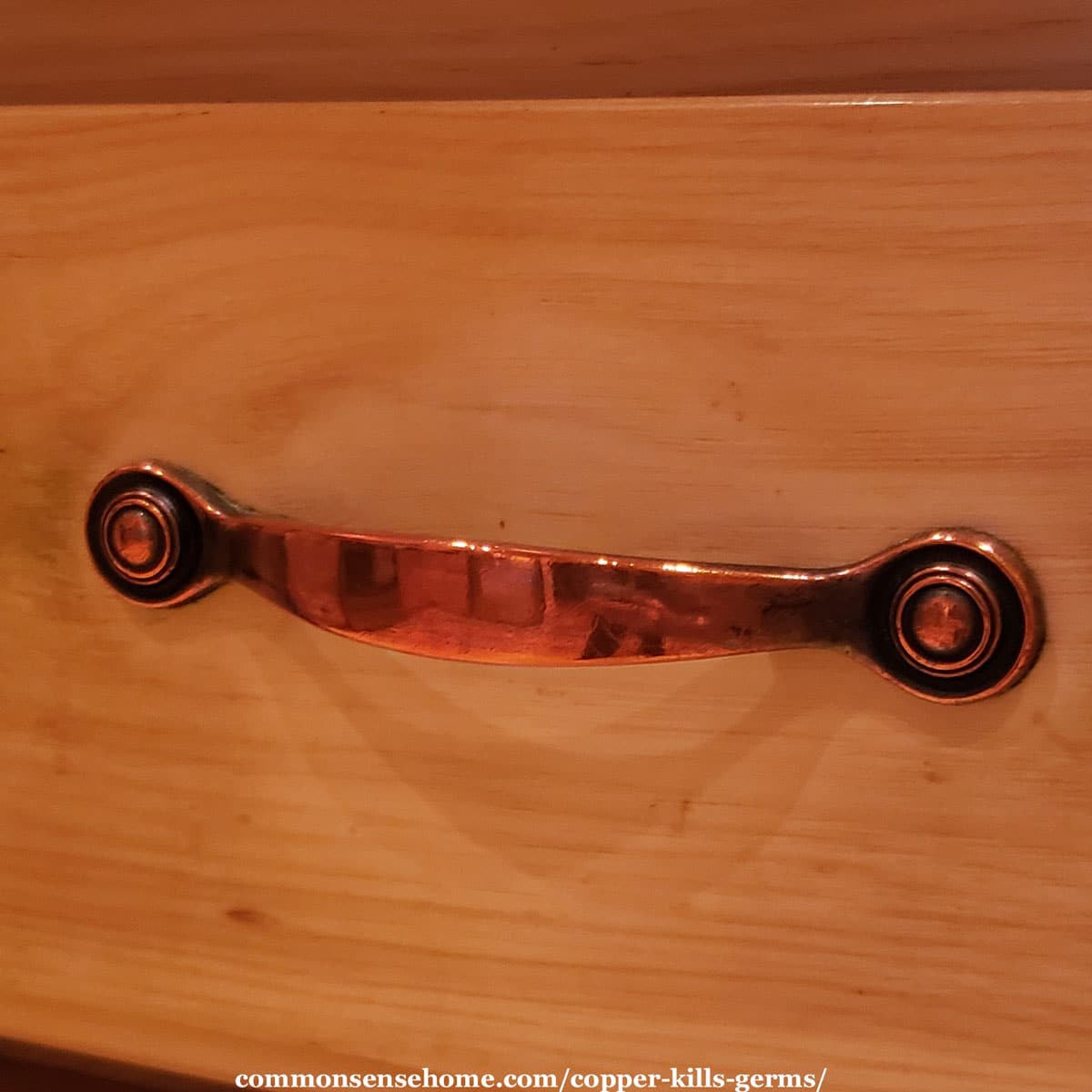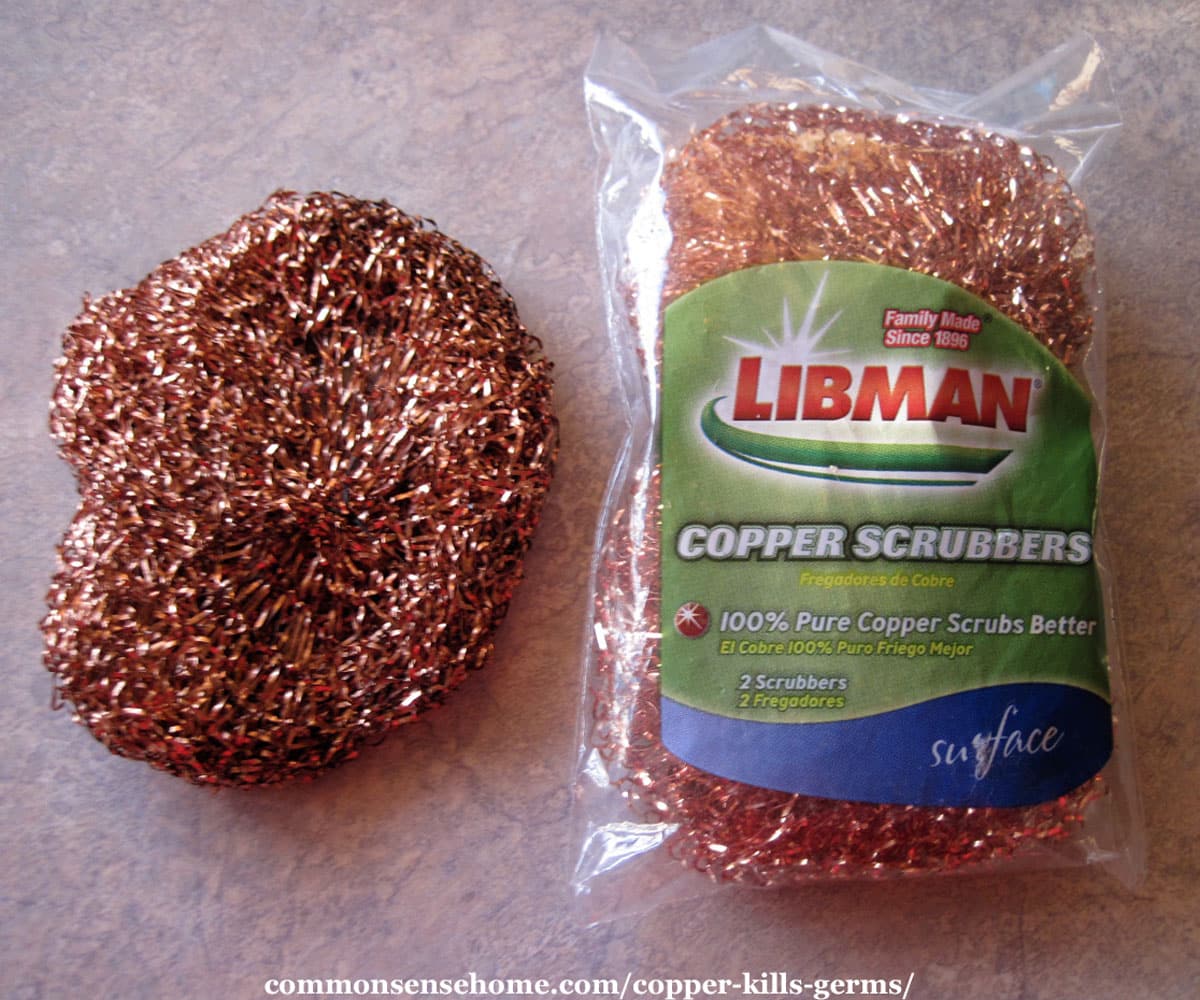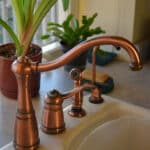Copper Kills Germs (Here’s How to Use it At Home)
This post may contain affiliate links. Read my full disclosure here.
Copper fixtures add warmth and character to your home, but they may also help prevent illness. We’ll share how copper kills germs, some of the best ways to use it in your home, and what can prevent it from working.

How Copper Kills Germs
With one valence electron, copper readily forms copper ions that readily react with other substances. These copper ions kill bacteria and viruses in several different ways.
Copper oxidizes to form cuprous oxide (Cu2O). These oxidized copper atoms pull electrons from the cellular membrane, punching holes in the cell wells. This weakens the cell wall, and when it fails, it kills the bacteria.
Before the cell membrane fails completely, the bacterial cell tries to adapt to the environment, drawing copper ions into the cell. Once there, the ions disrupt cellular functions. They can destroy the DNA, break down RNA, and disrupt energy production and respiration.
This microbial disruption works so well that the environmental protection agency (EPA) registered copper surfaces for use against Sars-CoV-2, the virus that causes COVID-19.
Tested antimicrobial copper alloys contact killed over 99% of viruses within two hours.
Supporting Studies
The study “Metallic Copper as an Antimicrobial Surface” examined the use of copper for controlling the spread of bacteria, viruses, and yeasts in health care settings. They determined that no bacterial fully resistant to copper have been found, and recommended more copper use.
Another study looked at how the copper ions killed germs, and found that even in small amounts, copper had an antibacterial effect. Soiled copper surfaces were less effective at eliminating germs. (Not surprisingly, regular cleaning is still a good idea, even if a surface naturally reduces harmful bacteria.)
A study in Asklepios Clinic, in Hamburg, Germany used copper to fight antibiotic resistant bacteria:
During the trial, two hospital wards were equipped with the door handles, door plates and light switches and checked over a period of several months in the summer of 2008 and winter 2008/2009. The adjacent areas kept their usual aluminum, stainless steel or plastic handles and switches.
Under normal daily conditions the level of multi-resistant Staphylococci Aureus (MRSA) bacteria (in the test wards) decreased by a third, and their resettlement on copper door handles and switches decreased considerably.On wards equipped with copper handles a lowered infection rate in patients was also observed.
Copper fittings beat bactDoneeria
The study “Copper Alloy Touch Surfaces in Healthcare Facilities: An Effective Solution to Prevent Bacterial Spreading” found similar results.
Using Copper in Your Home
Copper is a great addition to a Common Sense Home, combining beauty and function.
First off, copper pipes kill bacteria. The ancients knew it, and modern science confirms it. If you need to repair or install plumbing, opt for copper instead of plastic. Plastic is fine for drain pipes, but good copper pipes will last a lifetime and help keep your water safe.
Would you like to save this?
Regular hand washing is important, but your sink may help keep you healthy in another way, too. If you’re building or remodeling, consider copper fixtures. We have a copper faucet in the kitchen, and copper sinks are available, too.
We have copper handles on all the cabinets, and brass door handles. Copper alloys such as brass, bronze, and copper nickel also kill germs.
Note: Most fixtures have a coating on them to protect the copper, but with regular use, this coating wears off. Our most used drawer pulls are polished bright and shiny.
Target your messiest areas for using copper fixtures to kill germs, like the kitchen or main bathroom. 100% copper kitchen scrubbers won’t rust, and kill bacteria as they sit, unlike kitchen sponges, which breed bacteria.

For those who want a more direct approach, you can try solid copper nasal wands to swab your nose. Given that bacteria need a couple of hours on a copper surface to die off, these may not be effective. If you’ve had great results using a nose wand, I’d love to hear your story.
Antibacterial Fabric Infused with Copper
Given recent events, there’s been more interest in antibacterial fabrics. Studies show that copper infused fabric is antibacterial and not toxic to human skin cells.
Copperfit sells copper infused apparel and compression products. Copper Clothing Limited sells bed sheets, socks, masks, gloves, pajamas and more. Natural Home sells copper infused products such as mattress pads, pillows, and bedding sets.
Copper isn’t the only naturally antibacterial option…
Many people don’t realize this, but wood is also naturally antibacterial.
In the article, “4 Reasons Wooden Cutting Boards are Best“, we share which woods you want to use, and how to take care of them. Copper and wood belong in every Common Sense Home.
More Home Remedies and Natural Health Tips
Our bodies are made to heal and fight off infection. It’s our job to find the best tools to naturally support good health.
More Home Remedies
for Cold and Flu Season
Treat and prevent cold & flu naturally.



Laurie –
I loved this article and all the links made in it. It just reinformces my desire, as well as the need, to get as much plastic out of my life as possible to improve my health and the environment my family lives in.
Thank you so much.
I’m glad you found it helpful. I thought the information was interesting when I was researching it. It’s a shame it’s not more widely known.
So, is there a ‘best’ way to clean copper, in order to not lose it’s benefits? And re the ‘covering’ copper products have, does it inhibit the beneficial aspects of having copper products like door/drawer handles?
Ideally to maximize the germ fighting capabilities of the metal, you’d want to remove the protective anti-tarnish coating, but realistically, it’ll wear off with use.
For cleaning copper, a mil acid or mild abrasive, followed by a rinse and buff dry will remove buildup. There are commercial copper cleaners on the market, but household items like tomato paste, or a paste of equal parts flour and vinegar will get the job done.
Thank you for this – we are doing some remodeling and are insisting on copper pipe for the water lines. This adds to the long list of reasons for using copper.
I know in many areas they push for PEX because of ease of installation, but bacteria grow and breed on plastic surfaces that simply cannot grow on copper.